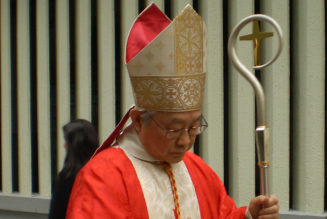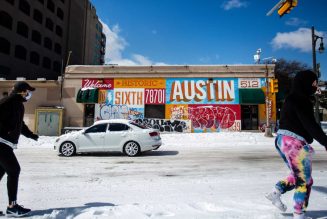
Here’s what I saw, two days before Christmas, when wrote my “On Religion” column about the Religion News Association’s poll to pick the Top 10 religion-news stories in 2019.
I saw this item: “A gunman kills 51 worshipers and wounds 39 at two mosques in Christchurch, New Zealand. An Australian linked to anti-Muslim and white-supremacist statements faces charges. New Zealand quickly enacts new gun restrictions.” That ended up being the No. 2 story of the year.
But I also saw this: “Gunmen kill one person at a Poway, Calif., synagogue; two others outside a German synagogue; and three in a Jersey City kosher market. Other anti-Semitic attacks and threats increase, particularly in New York City.” That ended up at No. 10 in the poll.
I also saw this: “A terrorist group in Sri Lanka, claiming loyalty to the so-called Islamic State, kills more than 250 and wounds hundreds in suicide bombings at churches and hotels on Easter Sunday.” That slaughter on Christianity’s holiest day fell all the way to No. 17.
Of course, there were other attacks on believers in other sanctuaries during 2019 and I had no way to know what would happen in the next few days — especially in Texas and New York City. In the GetReligion podcast about the RNA poll, I tried to connect all of those blood-red dots (including the role anti-Semitism played in British life in 2019).
I knew that the #MeToo crisis among Southern Baptists was a huge story. Ditto for the concrete signs of schism among Southern Methodists. Still, in my column, I said:
As my No. 1 story, I combined several poll options to focus on the year’s hellish uptick in attacks on worshipers in mosques, Jewish facilities and churches, including 250 killed in terrorist attacks on Easter in Sri Lanka.
What is there to say, less than two weeks later, as the sickening attacks on Jews shake New York City?
Well, there was this headline at The Atlantic:
Jews Are Going Underground
A month of terrible anti-Semitic attacks culminated with a stabbing yesterday of multiple people at a Hanukkah celebration at a rabbi’s home in Monsey, New York.
The overture by historian Deborah Lipstadt contains a stunning symbolic detail:
In a month of terrible anti-Semitic attacks, including a stabbing … of multiple people at a Hanukkah celebration at a rabbi’s home in Monsey, New York, the news that most depressed me did not involve violence. It was not something done to Jews but something Jews did. A synagogue in the Netherlands is no longer publicly posting the times of prayer services. If you want to join a service, you have to know someone who is a member of the community. …
Why has the news that a synagogue in the Netherlands stopped posting the time of services upset me above all? Because it is vivid proof that anti-Semitism is driving Jews underground in the West.
For some time now, many kippah-wearing Jews have adopted the habit of wearing baseball caps when visiting Europe. Young people think twice before wearing Israeli-flag T-shirts when they wander the streets of Paris. Or before carrying a backpack with the name of their Jewish youth group prominently displayed.
More? Emma Green — no surprise there — dug deeper in New York. Here’s that headline at The Atlantic:
‘We’re Not Safe as Jews in New York’
The Monsey stabbing is the latest in an escalating drumbeat of anti-Semitic violence in the hub of American Jewish life.
In New York City? Here’s the crucial summary from Green:
Jews have been in New York since before the city got its name, and have deeply influenced its culture. At one point, they made up as much as a quarter of its population. Now, according to researchers at Brandeis University, roughly 1.7 million Jews live in the metropolitan area, nearly 10 percent of the population. By comparison, Jews make up roughly 2 percent of the United States population as a whole.
Here, of all places, Jews should feel safe. But the Monsey stabbing is just the latest in an escalating drumbeat of violence in the area. Less than three weeks ago, a pair of assailants allegedly murdered two Jews, a law-enforcement officer, and a clerk at a kosher grocery store in Jersey City, New Jersey. There have been at least 13 anti-Semitic incidents in New York State since early December, according to Governor Andrew Cuomo, and at least 10 in the New York–New Jersey area in the past week alone, according to the Anti-Defamation League. The Monsey attack could mark a fundamental turning point for Jews in New York, and across the country: Jews are being targeted for violence, whether they live in the heart of Brooklyn or the suburbs of Rockland County, where Monsey is located. “I think the reality is seeping in,” Bernstein said. “It doesn’t matter who you are [or] what your religious affiliation is. We’re not safe as Jews in New York.”
This is news, but it isn’t really new.
Only two weeks earlier, Green had written a “think piece” at The Atlantic with this headline — focusing on a trend that was linger just outside the headlines, like a fever that many newsroom managers were trying to ignore.
American Jews Are Terrified
A deadly shooting at a kosher grocery store in New Jersey is the latest manifestation of anti-Semitic violence that doesn’t fit in a neat, ideological box.
The key idea here: This would be an easier story to cover if it fit into America’s new journalism marketplace.
You know: The niche-news, advocacy journalism systems in which news reports are crafted to fire up true believers on one side or the other of the bitter divides between red and blue zip codes, between Middle America and coastal elites, between people in Make America Great Again hats and those plugged into the world of woke Twitter.
<div class="sqs-block embed-block sqs-block-embed" data-block-json="{"cache_age":"3153600000","authorUrl":"https://twitter.com/mottiseligson","width":550,"height":null,"hSize":null,"resolveObject":"Tweet","html":"
Reports of a stabbing attack at a synagogue in Monsey, NY. Multiple victims.
\u2014 Motti Seligson (@mottiseligson) December 29, 2019
\n","url":"https://twitter.com/mottiseligson/status/1211123411537289216?ref_src=twsrc%5Etfw%7Ctwcamp%5Etweetembed%7Ctwterm%5E1211124789781381122&ref_url=https%3A%2F%2Fwww.thedailybeast.com%2Fmultiple-victims-reported-in-stabbing-attack-near-new-york-synagogue","resolvedBy":"twitter","floatDir":null,"authorName":"Motti Seligson","version":"1.0","resolved":true,"type":"rich","providerName":"Twitter","providerUrl":"https://twitter.com"}” data-block-type=”22″ id=”block-yui_3_17_2_1_1577717329256_54274″>
Reports of a stabbing attack at a synagogue in Monsey, NY. Multiple victims.
— Motti Seligson (@mottiseligson) December 29, 2019
If only it was easier to blame The Usual Suspects for all of this. At this point, American Jews — like everyone else — are bitterly divided, when arguing about root causes:
Here’s some crucial summary material from Green:
In recent months, America has faced nearly nonstop reports of anti-Semitism in all forms. A swastika scrawled on the outside of a synagogue. A string of assaults against Orthodox Jews in Brooklyn. Jewish students pushed out of progressive circles on campuses because of their presumed views on Israel. Slurs shouted at Jews out shopping during a measles outbreak. Especially in the realm of politics, fear is extremely close to the surface: Any statement or action from the Trump administration related to Jews immediately conjures intense backlash from progressives, whether or not it’s based on facts. …
This is the pernicious nature of anti-Semitism: It emerges in many different forms, from all sides of the political spectrum. It is impossible to name a single enemy responsible for the apparent recent spike of anti-Semitic incidents in the United States; Jew hatred easily shape-shifts to fit the purposes of many ideologies. Many Jews feel scared by anti-Semitic violence and discrimination, and yet they disagree about its source and cause.
I could go on and on with this, pointing to a long list of sobering reports, including this Julie Zauzmer piece at The Washington Post — “For New York’s Orthodox Jews, a fearful present brings up echoes of the violent past.” What about The New York Times? It appears to have taken some time for editors there to be shaken awake by what was happening to Orthodox Jews in and around their city. But this eventually turned into a hard-news story that demanded deeper coverage.
As you would expect, Jewish media have offered substantial coverage. I read The Forward, which offered this take on the Big Idea right now — fear. This is a must-read feature:
‘I Have Stopped Wearing My Magen David’:
27 Jews On What It Feels Like To Be Afraid For Their Lives
But here is the obvious question that Americans in the heartland may be asking, if their news coverage is limited to seeing fleeting reports on television or just glancing at headlines: How do these thugs know who to attack? Are they really spotting people wearing tiny necklaces?
The vast majority of these attacks are, of course, being directed at people who are literally — there is no way to avoid saying this — wearing their Jewish faith in ways that can be spotted as they walk down the sidewalk or board a subway train.
In other words, most of these attacks are on Orthodox Jews.
Why does this make the story more complicated? Why is that a subject that plays better on one side of America’s new advocacy journalism marketplace than on the other? Are there “culture wars” and political-doctrinal clashes among Jews that affect the coverage of this story? Of course there are.
Let’s end this way-to-short collection of stories and essays with a short, shattering opinion piece at The Forward, by Batya Ungar-Sargon. It ran with this headline:
Why No One Can Talk About The Attacks Against Orthodox Jews
Read between the lines in this summary passage:
After the massacre at a Pittsburgh synagogue on Shabbat that killed 11 people last year, and another fatal shooting at a shul in Poway, California six months later, one often heard that the great threat to Jews — even the only threat — comes from white supremacy. Conventional wisdom said it was the political right, and the right’s avatar in the White House, that was to blame for the rising levels of hate against Jews.
But the majority of the perpetrators of the Brooklyn attacks, and the suspects in Jersey City — who were killed in a shootout with the police — and now Monsey, were not white, leaving many at a loss about how to explain it or even talk about it. There is little evidence that these attacks are ideologically motivated, at least in terms of the ideologies of hate we are most familiar with.
And therein lies the trouble with talking about the violent attacks against Orthodox Jews: At a time when ideology seems to reign supreme in the chattering and political classes, the return of pogroms to Jewish life on American soil transcends ideology. In the fight against anti-Semitism, you don’t get to easily blame your traditional enemies — which, in the age of Trump, is a non-starter for most people.
You need more?
… Conspiracy theories flourish on the left as well in today’s day and age. They twist and torque those rigid ideologies to which so many are enslaved, reshaping the extremes from polar opposites into a horseshoe whose ends meet — again and again — to justify, excuse, or muzzle criticism of anti-Semitism.
It has resulted in a staggering, shameful silence when it comes to speaking out on behalf of the wave of pogroms against the Orthodox. For many people, it seems when they can’t blame the other side of the political aisle, they would rather say nothing at all.
Welcome to American politics and, thus, to American journalism in 2020.
<div class="sqs-block embed-block sqs-block-embed" data-block-json="{"cache_age":"3153600000","authorUrl":"https://twitter.com/SethAMandel","width":550,"height":null,"hSize":null,"resolveObject":"Tweet","html":"
I often relay stories of being stopped from eating off nonkosher menus in NYC by non-Jewish workers (say, in Dunkin Donuts, which has a kosher and nonkosher list of products). Being visibly Jewish in NYC meant something very special, very warm, very home.
Now it means fear.
\u2014 Seth Mandel (@SethAMandel) December 27, 2019
\n","url":"https://twitter.com/sethamandel/status/1210629967333273604?s=12","resolvedBy":"twitter","floatDir":null,"authorName":"Seth Mandel","version":"1.0","resolved":true,"type":"rich","providerName":"Twitter","providerUrl":"https://twitter.com"}” data-block-type=”22″ id=”block-yui_3_17_2_1_1577717329256_68179″>
I often relay stories of being stopped from eating off nonkosher menus in NYC by non-Jewish workers (say, in Dunkin Donuts, which has a kosher and nonkosher list of products). Being visibly Jewish in NYC meant something very special, very warm, very home.
Now it means fear.
— Seth Mandel (@SethAMandel) December 27, 2019




